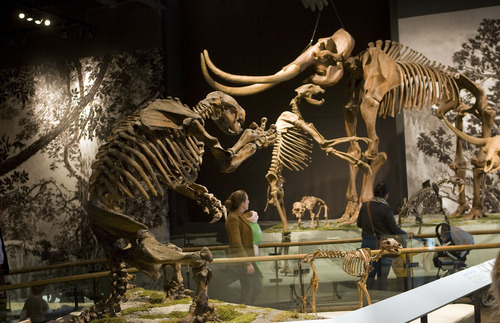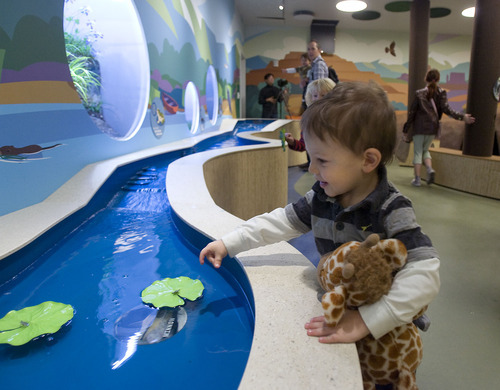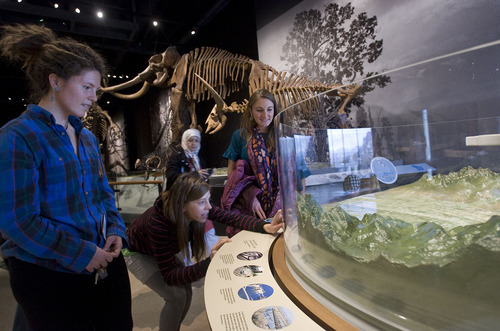This is an archived article that was published on sltrib.com in 2011, and information in the article may be outdated. It is provided only for personal research purposes and may not be reprinted.
By lisa schencker
The Salt Lake Tribune
Seventeen-month-old Miles Barabino took one look at the giant, crocodile-like Deinosuchus skeleton — its jaws open as if ready to eat the toddler — and said one word: "Cuddle."
Cuddling the ancient creatures on display at the new Natural History Museum of Utah was perhaps one of the only things children and other visitors weren't allowed to do at the museum's grand opening Friday. The $102 million museum, which opened about a year after the old museum closed, features interactive displays and exhibits at every turn, in addition to the towering dinos Utahns have come to expect.
"It's breathtaking," said Miles' father, John Barabino of Salt Lake City, as he stood on an elevated walkway Friday between dinosaur skeletons. Barabino was one of the more than 3,000 lucky people to grab free tickets online to the first public day at the museum. All the tickets were claimed before the museum opened.
"I think probably the most exciting part is having this museum in Utah, given the history of the state the geology of the state," Barabino said, referring to Utah's rich natural surroundings and reputation as a treasure trove of priceless bones and fossils. "Having it in New York or San Francisco just wouldn't be the same."
As adults gaped at the tremendous reconstructed skeletons and carefully designed displays, dozens of young and home-schooled children frenetically bounced from exhibit to exhibit Friday morning.
In the Great Salt Lake exhibit room, Peter Chapa, 3, turned a crank that showered water over a model of the Salt Lake Valley, showing the areas covered by Lake Bonneville 16,000 to 14,500 years ago. It wasn't long before he ran to a nearby tube holding tiny brine shrimp common to the Great Salt Lake.
"There's so much going on for him, he can't keep his focus. He just wants to keep moving," said Peter's father and namesake, Peter Chapa.
Chapa said he was initially disappointed to see some of the surrounding natural grasses cleared to make way for the museum, which was previously housed on the University of Utah's campus. But he said after touring the museum Friday, it seemed worth it.
"Ultimately, I can't say I'm too disappointed by it," Chapa said.
Further into the museum, amid its First Peoples exhibit, about half a dozen children played in a reconstruction of a Utah archaeological site. Tiny tots sat in post holes in the faux dirt while older children ran back and forth climbing over steps and uneven ground.
"I would call this an obstacle course," said Freddy Gowski, 4.
His mother, however, called it something else: "Overwhelmingly cool," after explaining to Freddy that he was playing in an archaeological site "where they dig things up that existed a long time ago."
"I'm looking forward to coming back actually without children, just so I can scope it out and explain it more effectively to them," Freddy's mom Virginia Gowski said.
Children weren't the only ones amazed. Adults marveled at a dozen huge horned dinosaur heads hanging from a wall like works of art. They halted in front of a wall of skulls tracing human evolution. And they ascended to the Sky Terrace, where views of the Great Salt Lake, downtown Salt Lake City and the snowy Wasatch Mountains extended before them.
"This is spectacular," said Valerie Henderson who visited the museum Friday with her husband and two-month-old daughter, leaving her toddler with a friend so she could fully take it all in. She said she's eager to return with her toddler and excited to show it off to friends from out-of-town. "We're so excited this museum has opened because now when the weather is bad we have the most amazing place to take them."
On the fifth level, in the Native Voices exhibit about the traditions of Utah's five American Indian nations, Yolanda Francisco-Nez was moved to tears.
Francisco-Nez is a member of Dine tribe. She's also coordinator of the Salt Lake City Mayor's Office of Diversity and Human Rights, but visited the museum Friday out of personal interest.
"I feel proud that we are able to share and inform and educate other populations about the original people who lived in this country," Francisco-Nez said, "who still live in this country." —
Natural History Museum of Utah
P The new museum will now be open daily from 10 a.m. to 5 p.m. and from 10 a.m. to 9 p.m. on Wednesdays. It will be closed Thanksgiving Day and Christmas Day. Admission is $9 for adults; $7 for those over age 65 and those between the ages of 13-24; $6 for children ages 3-12; and free for children 2 and under and University of Utah students, faculty and staff.









